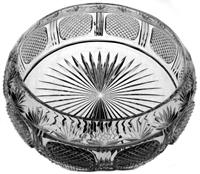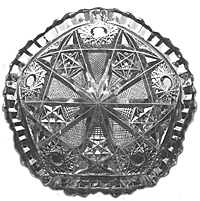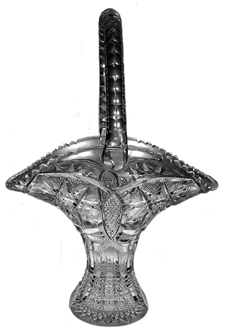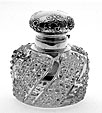Brilliant Era Glass Cutting House Catalogs
About the 1918 Meriden Catalog
The 168 page 1918 Meriden catalog presented here is based on a relatively poor photocopy shared by LABAC member Bill Evans. Two pages seem to be missing from this set. The page numbers were probably typed onto earlier copies of the page images, as they do not appear to have been typeset.
Many of the page images bear handwritten annotations suggesting factory origins, including price changes (e.g., p. 98) and inventory counts (e.g., p. 100). Duplicated plate numbers (with and without annotations) suggest that page images probably were taken from two or more surviving copies of the catalog.

Fern dish cut in the Old Irish pattern by Meriden. The cutting design features a central rayed star and rounded rectangles of diamondpoint separated by triple vertical prisms. 9” rim diameter, 3 1/2” tall. This piece is pictured on catalog p. 45 (upper left). Also see the LABAC PBM book p. 100 or Flash Card set Five, card 61.
These photocopied pages closely resemble catalog copies made and circulated by Paul Miles during the late 1980s and early 1990s. We speculate that Paul Miles may have assembled these pages during the late 1980s from two or more Meriden catalogs, and perhaps Paul added the typewritten page numbers. We don't know where the original catalogs are, or whether they have survived.

Round saucer (also called a handleless nappy or dish) cut in pattern No. 165 by Meriden. The design is based on a simple five-way symmetric circle-of-wedges pattern. The predominance of “five” in the pattern design is evident. There are five wedges, five-pointed hobstars, five lattice cuttings, and five rim scallops.
There is a plain button hobstar beneath each rim scallop, with a crosshatched field immediately adjacent to plain button hobstars. There is a five point hobstar below the rim at each location where two adjacent scallops descend to meet. Lattice cutting is found in five triangles about the center. Each of the five rim scallops bears nine teeth. 4 15/16” in diameter and 1 ½” high.
Although this piece exhibits at least four of the design traits usually associated with William C. Anderson, there is no evidence that Anderson ever designed for or provided cut glass patterns to Meriden. Image provided by Franz Hellwig.
The present material was reprinted July 2006 in the LABAC Cycle Ten "PBM" book. The LABAC Cycle Seven "PBHS" book earlier reprinted a Meriden catalog fragment that seems to be a very incomplete page set derived from the present material. As noted in the PBHS preface, presence of the Meriden Beverly and Patrician patterns (both patented by Meriden in 1918) dates this catalog to the period after World War One, probably 1918 or at most a few years later. Given the extent of the catalog and the fact that two different copies were accessible, we might hypothesize that Meriden had resumed operations interrupted by the War, and was vigorously pursuing sales of cut glass soon after the close of the Brilliant era.

Handled flower basket cut in geometric pattern No. 136 by Meriden. The hobstars having points of crosscutting and fan accent between points are found on many of the Meriden geometric patterns. Vesicas of fine hobnail beneath handle attachments, step cut waist. See catalog p. 98, PBM p. 152 or RN3 p. 368. Image provided by Franz Hellwig.





